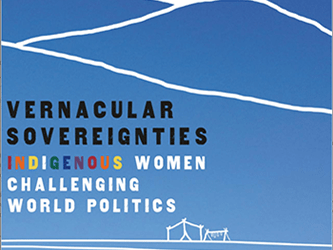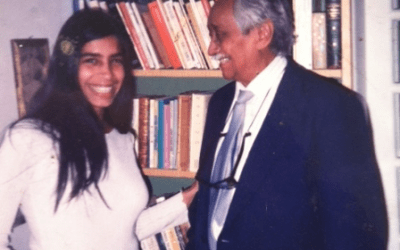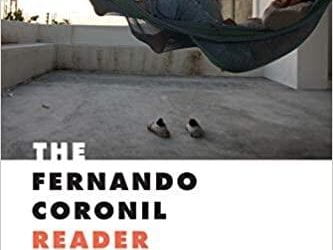From Canaima to Canaima National Park
When Literature Buries Indigenous Geographies
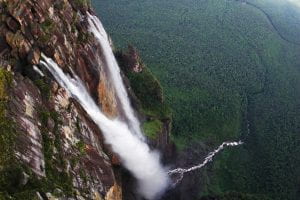
Angel Falls in Canaima National Park, by Luis Carillo, 2005 https://commons.wikimedia.org/wiki/File:Angel_Falls_in_Venezuela.jpg
Sometimes we find our research topics in other people’s footnotes. I first read Canaima (1935), a lesser-studied novel by author, teacher and former president Rómulo Gallegos (1884-1969), as a student of Latin American literature in the doctoral program at Johns Hopkins University. I had to wait until the 518th footnote for an explanation—though insufficient—of the book’s title. According to Charles Minguet, editor of the critical edition, “The Indigenous person fears kanaima, who does not exist as a God, but rather as an enemy, and upon being attacked by this [enemy], he screams.” The brevity of this description only served to further ignite my curiosity. Is Canaima—the incorporeal jungle spirit of Gallegos’ novel—actually a person? Is it spelled with a “k”? Does it attack people? These questions inspired one of my dissertation chapters, which will soon be published as part of my first book, Mapping the Amazon: Literary Geography after the Rubber Boom.
The ethnographic work of anthropologist Neil Whitehead would later clarify that kanaima with a “k” designates a kind of shaman as well as the ritual killing that he performs and that consists of stalking, attacking and then consuming the body of a victim. This pan-Indigenous phenomenon occurs throughout the vast fluvial region known as the Guiana Shield, which stretches across the Amazon and Orinoco River basins. There are practicing kanaimas among several Carib peoples including the Karinya, Pemón, Makushi, Akawaio and Patamuna. Other Carib peoples (the Waiwai, Ye’kwana and Wayana), some Arawak peoples (the Wapishana and Lokono), and the Warao know about the practice and fear it. The cause for that fear became very apparent when I read the graphic descriptions of kanaima documented by Whitehead and sometimes illustrated with sketches by his Patamuna informants. My research led me to understand that for kanaimas, consuming the body of a victim is a cultural duty that allows them to access a shamanic consciousness, communicate with the creator Makunaima, and thus, increase their power. Understanding the silence surrounding these Indigenous meanings in studies on Canaima and tracing the relationship between the shamanic practice, the novel and the national park of the same name, would take me along circuitous paths of cultural appropriation, always paved with good intentions.
Canaima tells the story of Marcos Vargas, an impulsive youth from Ciudad Bolívar on the shores of the Orinoco. He dreams of risking everything in “the adventurers’ Guayana,” the epithet he uses to refer to the Guiana Shield whose rivers and streams extend through nearly half of Venezuela’s national territory. Vargas learns about the adventures associated with the region by listening to the stories of rubber tappers who return to the city at the end of each season. In the end, the hero fulfills his fantasies as a foreman of a small rubber venture. However, rather than carrying out the great feats he imagined in a jungle that he believed to be virgin, he confronts the devastating effects of the extraction of natural resources—rubber, tonka beans and gold—from the region. Gradually he begins to distance himself from his society of origin, thus severing ties with the source of the human and ecological abuses he witnesses in the jungle. Finally, he settles in a Ye’kwana community and partners with a woman called Aymara. Years later, as the novel closes, he sends their child to the capital for an education.
This critique of extractive economies filters through a discourse known as “regionalism” in Latin American literature. With exhaustive descriptions and vernacular language, this literary mode, dominant in the first decades of the 20th century, sought to capture and preserve the cultural diversity of the nation. As a decidedly nostalgic literary style, regionalism coincided with the acceleration of Latin American processes of modernization aimed at integrating isolated areas, homogenizing national economies and flattening the idiosyncratic textures that regionalist novels brought into high relief. As Carlos Alonso proposed, the regionalist imagination invented and exoticized the idea of an uncontaminated local culture as a response to the identity crisis incited by modernization.
In Venezuela, the formation of an oil state at the beginning of the 20th century accentuated that crisis. Fernando Coronil, a Venezuelan anthropologist and former visiting professor of the David Rockefeller Center for Latin American Studies at Harvard, indicated that although the extractive activities of the time were predominantly located along the country’s northern coast, the oil industry restructured economic space throughout the country. Furthermore, without government schools equipped to instill the concept of national citizenship in Venezuela’s rural areas, the “school” of the oil system—as workers called it—delivered lessons in economic citizenship for a modern Venezuela.
In the face of president Juan Vicente Gómez’s concession of oil fields to foreign companies, Gallegos created a romantic character who takes refuge in an alternative onto-epistemology called “those worlds of Canaima.” In other words, he used regionalism to construct an inherently Venezuelan landscape by turning the Indigenous practice of kanaima into a literary trope. Canaima with a “c” is the destructive evil spread by “the rational ones, the suckers of rubber tree’s blood, the violators of the dream of gold,” but it is also the enigmatic and mutable force that draws Marcos Vargas into the jungle. The rubber tappers refer pejoratively to Marcos Vargas’ immersion in the jungle by circulating stories about Canaima getting stuck “in the rational one’s head,” but his solitary contemplation of the tropical vegetation and eventual shamanic convergence with plant species reveal a dynamic forest comprised of subjects like him. Those worlds of Canaima uncovered through Vargas’ journey serve to contrast with the rational objectification of the forest implied in its codification as natural resources.
I have been unable to ascertain exactly how Gallegos became familiar with the idea of Canaima that he laid out in his novel. He does not mention it once in the notebook where he meticulously recorded his observations during a brief stay in Guayana. That being said, a few of Canaima’s passages are suspiciously similar to the accounts of the botanist Richard Schomburgk and the explorer Theodor Koch-Grünberg. Both documented western distortions of kanaima as a disembodied vengeful force, but through their Pemón informants, they also compiled details about famous kanaimas and explanations of the ritual act.
Although Gallegos evokes the concept of a mystical “Canaima” to emblematize Venezuelan Guayana, the regionalist discourse articulated by Marcos Vargas’ spiritual journey nonetheless runs into surprising descriptions that coincide with some of the most startling aspects of kanaima found in Schomburgk and Koch-Grünberg. Like an actively hunting kanaima who takes the form of a jaguar, Vargas learns to eat raw meat, senses claws at his hands and, in an inexplicable scene—which literary critics have curiously overlooked—he attacks a man from behind with a machete just as kanaimas attack their victims. The emergence of these strange details in the novel seem to confirm, as Lúcia Sá proposed, that in Gallegos the word “Canaima” exceeds the definition provided by the narrator.
Studies on Canaima have recognized in such complex textual richness an anomalous approach to regional otherness, but because Latin American regionalist novels—also called telluric novels—tend to personify the land, in the 1960s “Canaima” became synonymous with the region described in the text. Gallegos was nominated for the Nobel Prize in Literature in 1960, and in 1962 the Venezuelan state chose the title of his second novel to designate what would be for some time the largest national park in the world. Canaima National Park, now a UNESCO World Heritage Site and popular tourist destination, is situated in the Gran Sabana region of Venezuelan Guayana and occupies nearly 12,000 square miles. From its characteristic plateaus known as tepui, the world’s tallest waterfall, Angel Falls, cascades to the earth. Today, most of the approximately 30,000 Pemón people live within the perimeter of the park, which for them is comprised not of tourist attractions but rather of sacred beings.
The Venezuelan state’s presence as a national park in Pemón ancestral lands has produced conflicts related to the titling and use of collective property. As one Pemón activist insisted, invoking the International Labor Organisation’s Indigenous and Tribal Peoples Convention of 1989, “We are not inside the national park. The national park is in our communities, which is why whatever is done must be done only after we are first consulted.” Pemón people must now fight to maintain the scientifically proven practices of slash and burn agriculture while struggling with the effects of legal and illegal mining. Additionally, since 2016, the park overlaps with the Orinoco Mining Arc National Strategic Development Zone, an area rich in gold, copper, diamond, coltan, iron and bauxite reserves, and therefore designated for mining exploration. In February 2019, under President Nicolás Maduro’s administration, a violent encounter between the military and Pemón protestors caused by the entrance of humanitarian aid in the park resulted in the death of three Pemón individuals. As a result of such confrontations, the Pemón people of Canaima National Park daily face the kind of violence that Canaima denounced: the forced integration of the periphery into the national economic center.
In the meantime, “Canaima” has gone from designating a special riverine region to function metonymically as the essence of the nation. In 2016 an executive order called for the creation of a new open-source operating system for the National Public Administration; the name chosen was “Canaima.” The website for the operating system previously featured a banner announcing, “With Canaima we speak Venezuelan.” Other examples of the software as an expression of the Venezuelanization of computing abound. For example, an advertisement for Canaima version 3.0 bears the subtitle “with Venezuelan flavor.” The rhetorical maneuver of selectively co-opting whitewashed versions of folkloric characters and projecting their almost fictitious image as a symbol of the nation is not unique in the realm of Latin American regionalism. In the Argentine context, something similar happened with the gauchos, who were hired and mistreated by the incipient state to clear the frontier in the 19th century, only to later become symbols of the national spirit. The degree of distancing from the original referent seems to distinguish the Venezuelan case. Naming a national park after a practice of ritual killing already indicated an alarming lack of state sensitivity toward its native peoples, but using Canaima as shorthand for a national language exposes the complete cultural blindness with which the Bolivarian state takes hold of the symbolic capital of Indigenous peoples.
The indiscriminate use of the Carib term has produced vehement protests. Ricardo Delgado, a Pemón academic and former mayor of the municipality of Gran Sabana, protested the government’s thoughtless dissemination of the word kanaima on his personal blog:
I urge the national government to discontinue the use of the name Canaima for any more projects, because each time it is named, as everyone knows on an elemental level, the action and character of Canaima is invoked, whether the usage is Indigenous or not. This is why I say, and firmly believe, that there are now Canaimas everywhere, flogging citizens in their neighborhoods, infiltrating the armed forces, corrupting the police force, carrying prison batons.
Delgado’s urgent grievance suggests that in Pemón—as in other Indigenous languages such as Quechua—there is no meaning that mediates the relationship between the word and its referent. According to Delgado, saying “kanaima” calls kanaima forth. As a result, state ignorance toward Carib practices unleashes a real, physical threat unbeknownst to those who set it loose.
The state appropriation of this word eclipses another important meaning as well. For other Pemón people, kanaima also designates a harmonious way of being with the world. Pemón professor Lino Figueroa explores this sense of kanaima in Makunaima en el valle de los kanaimas (2007), a collection of stories based on the oral tradition of his Kamarakoto people. The book tells how Makunaima, following the lessons of his father Kaponokok, intuits how to care for the world around him and learn from it. A ritual kanaima killing constitutes part of his coming-of-age, but only as a brief episode in a much more extensive educational program, which, according to Kaponokok, “is not difficult if you treat things with respect and responsibility.” For Makunaima, kanaima becomes a corporeal and mental tether to the jungle landscape, a nuance of kanaima utterly absent in the state’s actions in the park.
The proliferation of “Canaima” in political discourse also obscures Gallegos’ albeit superficial meaning of Guayana as the place of alternative knowledge brought into view throughout Marcos Vargas’ fantastic journey. What endures, instead, is the inability of the state to hear the concerns of the regions it aspires to integrate, even when they use the same vocabulary. When Gallegos extracted kanaima from Carib cosmovision in order to use it as a concept in his regionalist literary project, he inadvertently gave the state permission to add it to the national lexicon. As the case of Canaima makes clear, such literary extraction is not merely a metaphor. In the transformation of Guayana from a proverbial site of riches for others to a source of innovative literary tropes, a literary cartography emerges that conceals the original geographic referent. If literature can intervene so insidiously in the lives of the people of fluvial jungles like Guayana, then reading literary works inspired by such regions today requires unearthing the worlds buried in their pages.
De Canaima al Parque Nacional Canaima
Cuando la literatura entierra geografías indígenas
Por Amanda M. Smith

Angel Falls in Canaima National Park / Salto Ángel en el Parque Nacional Canaima (Luis Carillo, 2005) https://commons.wikimedia.org/wiki/File:Angel_Falls_in_Venezuela.jpg
A veces los temas de investigación se encuentran en las notas a pie de página. Cuando yo era estudiante de literatura latinoamericana en el programa de doctorado de Johns Hopkins University, leí por primera vez Canaima (1935), una novela poco estudiada del autor, maestro y expresidente venezolano Rómulo Gallegos (1884-1969), pero tuve que esperar hasta la nota 518 para encontrar una explicación—aunque insuficiente—del origen del título del libro. Según Charles Minguet, el editor de la edición crítica,“El índigena teme a kanaima, quien no existe como dios, pero sí como enemigo, y al ser atacado por éste, grita”. La brevedad de la descripción solo sirvió para encender mi curiosidad. ¿Es Canaima—que en Gallegos es construido como un espíritu selvático incorpóreo—una persona? ¿Se escribe con “k”? ¿Ataca a la gente? Estas preguntas inspiraron uno de los capítulos de mi tesis que pronto se publicará como parte de mi primer libro, Mapping the Amazon: Literary Geography after the Rubber Boom.
La obra etnográfica del antropólogo Neil Whitehead luego me aclararía que kanaima con “k” nombra tanto a un tipo de chamán como a la matanza ritual que lleva a cabo y que consiste en acechar, atacar y luego consumir el cuerpo de su víctima. Se trata de un fenómeno pan-indígena propio del Escudo Guayanés, esa vasta región fluvial que abarca las cuencas del Amazonas y el Orinoco. Se encuentran kanaimas entre varios pueblos caribes como los Karinya, Pemón, Makushi, Akawaio y Patamuna. Otros pueblos caribes (los Waiwai, Ye’kwana y Wayana), algunos pueblos arawakos (los Wapishana y Lokono) y también los Warao conocen la práctica y la temen. Se me esclareció la causa de ese miedo cuando leí las gráficas descripciones de kanaima ofrecidas por Whitehead, y a veces ilustradas con bocetos de sus informantes Patamuna. Pero llegué a entender que, para los kanaimas, consumir el cuerpo de su víctima constituye un deber cultural que les permite acceder a una consciencia chamánica, comunicarse con el creador Makunaima, y así aumentar su poder. Entender el silencio sobre estos sentidos indígenas en los estudios sobre Canaima hasta llegar a trazar la relación entre el chamanismo, la novela y el parque nacional del mismo nombre, me llevaría a explorar los complejos procesos de apropiación de tierras indígenas siempre barnizados de buenas intenciones.
Canaima cuenta la historia de Marcos Vargas, un joven impulsivo de Ciudad Bolívar en las orillas del Orinoco, quien sueña con arriesgarse en la “Guayana de los aventureros”, el epíteto que usa para referirse al Escudo Guayanés cuyos ríos y afluentes se extienden por casi la mitad del territorio venezolano. Vargas se instruye en las aventuras asociadas con la región escuchando historias de los purgüeros que vuelven a la ciudad al final de cada temporada. El héroe, al fin, parece destinado a cumplir sus fantasías como capataz de una pequeña empresa cauchera pero en vez de protagonizar las hazañas imaginadas en una selva que creía virgen, encara los efectos devastadores de la extracción de recursos naturales—caucho, sarrapia y oro—de la que es objeto la región. Poco a poco se va alejando de su sociedad de origen, desasociándose así de la fuente de abusos humanos y ecológicos de los que es testigo en la selva. Finalmente, se instala en una comunidad Ye’kwana y se empareja con una mujer llamada Aymara. Años más tarde envía su hijo a la capital para educarse.
Esta crítica a las economías extractivas se filtra a través de un discurso conocido en la literatura latinoamericana como “regionalismo”. Mediante descripciones exhaustivas y lenguaje vernáculo, este modo literario dominante en las primeras décadas del siglo 20 buscaba registrar y preservar la diversidad cultural de una nación. Se trata de una corriente literaria de afán decididamente nostálgico que coincide con la aceleración de los procesos de modernización en América Latina destinados a integrar áreas aisladas, a homogeneizar las economías nacionales y a aplanar las texturas idiosincrásicas que las novelas regionalistas ponen de relieve. Como propuso Carlos Alonso, la imaginación regionalista inventa y exotiza lo autóctono como respuesta a la crisis cultural atizada por la modernización.
En Venezuela, la constitución de un estado petrolero a principios del siglo 20 acentúa esa crisis. Como indicó Fernando Coronil, el antropólogo venezolano y exprofesor visitante del David Rockefeller Center for Latin American Studies en Harvard, si bien la actividad extractiva se centraba por entonces en la costa del norte, la industria petrolera reestructuró el espacio económico en todo el país. Además, mientras las zonas rurales venezolanas carecían de escuelas equipadas para promover el concepto de ciudadanía nacional, la “escuela” creada en torno al sistema petrolero—así la llamaban los trabajadores—suministraba lecciones de ciudadanía económica para la Venezuela moderna.
Ante la concesión de tierras petroleras a empresas extranjeras durante la presidencia de Juan Vicente Gómez, Gallegos creó un personaje romántico que se refugia en una onto-epistemología alternativa denominada “esos mundos de Canaima”. En otras palabras, logró construir un paisaje regionalista autóctono al convertir la práctica indígena kanaima en un tropo literario. Canaima con “c” es la maldad arrasadora que difunden “los racionales, los chupadores de la sangre del árbol de goma, violadores del sueño del oro” pero es también la fuerza enigmática y mutable que arrastra a Marcos Vargas hacia la selva. Los caucheros se refieren despectivamente a la inmersión de Marcos Vargas en la selva cuando rumorean que Canaima se ha metido “en cabeza de racional”, pero la contemplación solitaria del monte y la eventual convergencia chamánica del personaje con otras especies le revelan un bosque dinámico compuesto de sujetos como él. Esos mundos de Canaima, expuestos a través de Vargas, sirven para contrastar con la objetivación racional del bosque implicada en su codificación como recursos naturales.
No he podido averiguar exactamente cómo Gallegos se familiarizó con la idea de Canaima tal como aparece planteada en su novela. No lo menciona en el cuaderno donde copió meticulosamente sus observaciones durante una breve estadía en Guayana. No obstante, algunos pasajes de Canaima se asemejan sospechosamente a los relatos del botánico Richard Schomburgk y del explorador Theodor Koch-Grünberg. Los dos documentaron distorsiones occidentales de kanaima como una fuerza vengativa descorporizada pero también recopilaron detalles sobre kanaimas famosos y explicaciones del acto ritual a través de sus informantes pemones. Aunque Gallegos vincula el concepto de un “Canaima” místico como emblema de la Guayana venezolana, el discurso regionalista que articula el viaje espiritual de Marcos Vargas sin embargo choca con descripciones sorprendentes que coinciden con algunos de los aspectos más sobrecogedores de kanaima. Como un kanaima cazador activo en forma de jaguar, Vargas aprende a comer carne cruda, siente que tiene garras en vez de manos y en una escena inexplicable—y curiosamente pasada por alto por los críticos literarios—ataca a un hombre por atrás con un machete tal y como atacan los kanaimas a sus víctimas. La irrupción de estos extraños pormenores en la novela parece confirmar, como sugirió Lúcia Sá, que en Gallegos el término “Canaima” excede la definición ofrecida por el narrador.
Los estudios de Canaima reconocen en su compleja riqueza textual un acercamiento anómalo a la otredad regional y así como otras novelas regionalistas latinoamericanas tienden a personificar la tierra misma—y por eso a veces también se llaman novelas telúricas—“Canaima” se convirtió en los años sesenta en sinónimo de la región descrita en el texto. Gallegos fue nominado al Premio Nobel de Literatura en 1960 y en 1962 el estado eligió el título de su segunda novela para designar lo que en un momento dado sería el parque nacional más grande del mundo. El Parque Nacional Canaima, un destino turístico popular también declarado Patrimonio de la Humanidad por la UNESCO se sitúa en la Guayana venezolana en la región de la Gran Sabana y ocupa más de 30,000 kilómetros cuadrados. De sus mesetas características conocidas como tepui cae la cascada más alta del mundo, el celebrado Salto Ángel. Dentro del perímetro del parque, vive la mayoría de los aproximadamente 30,000 pemones para quienes la región no está compuesta de atracciones turísticas sino de seres sagrados.
La incursión del estado venezolano al destinar tierras ancestrales pemones a un parque nacional ha producido conflictos sobre la titularidad y el uso de propiedades colectivas. Como afirmó un activista pemón al invocar el Convenio sobre Pueblos Indígenas y Tribales en Países Independientes de la Organización Internacional del Trabajo, “Nosotros no estamos dentro del Parque Nacional, el Parque Nacional está dentro de nuestras comunidades, y es por eso que lo que se haga debe ser primero consultado con nosotros.” Los pemones ahora luchan por mantener prácticas científicamente probadas como la tala y quema de árboles mientras se confrontan con los efectos de la minería sancionada e ilegal. Además, desde el 2016, el parque también se encuentra dentro de la Zona de Desarrollo Estratégico Nacional Arco Minero del Orinoco, un área con reservas de oro, cobre, diamante, coltán, hierro y bauxita, designada para la exploración minera. En febrero de 2019, bajo la administración del presidente Nicolás Maduro, un enfrentamiento violento entre militares y manifestantes pemones a causa de la entrada de ayuda humanitaria al parque resultó en la muerte de tres individuos pemones. Como resultado de estas circunstancias, los residentes pemones se enfrentan diariamente con el tipo de violencia que Canaima denunció bajo la forma de la integración forzada de la periferia al centro económico nacional.
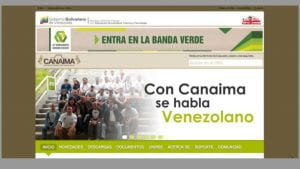
“With Canaima we speak Venezuelan,” / Con Canaima se habla venezolano, 2016 https://canaima.softwarelibre.gob.ve/
Mientras tanto “Canaima” ha pasado de designar una región ribereña especial a funcionar metonímicamente como la esencia de la nación. En 2016 por decreto presidencial se creó un sistema operativo de código abierto para la Administración Pública Nacional llamado “Canaima”. En la página web del sistema operativo solía haber un banner que anunciaba, “Con Canaima se habla venezolano”. Abundan otros ejemplos del software como expresión de la venezolanización de la informática. Por ejemplo, un anuncio para la versión Canaima 3.0 lleva como subtítulo “con sabor venezolano”. La maniobra retórica de apropiarse selectivamente de versiones blanqueadas de personajes folklóricos y proyectar su imagen casi ficticia como símbolo de la nación no es única en la esfera del regionalismo latinoamericano. También ocurrió, por ejemplo, con el gaucho que, contratado y abusado por el incipiente estado argentino en las luchas fronterizas del siglo 19, terminó convirtiéndose en símbolo del carácter nacional. El distanciamiento del referente original parece ser lo que distingue el caso venezolano. Si por un lado la idea de poner a un parque nacional el nombre de una práctica de matanza ritual indica una falta alarmante de sensibilidad estatal hacia sus pueblos originarios, por otro lado, la provocación de convertir a Canaima en una especie de lenguaje nacional subraya la ceguera cultural con la que el estado bolivariano parece querer adueñarse del capital simbólico de los pueblos de la Guayana.
El uso indiscriminado del vocablo caribe ha producido protestas vehementes. Ricardo Delgado, académico pemón y exalcalde de la municipalidad de Gran Sabana, publicó en su blog personal una denuncia de la diseminación irreflexiva de la palabra kanaima por parte del gobierno:
Exhorto desde este espacio que el Gobierno nacional no siga usando el Nombre de Canaima para ningún otro proyecto, porque cada vez que se nombra, como todos saben de la manera más elemental, se invoca la acción y el carácter de Canaima, sea éste indígena o no. Por eso digo, y creo firmemente, que ahora hay Canaimas por todas partes, en los barrios azotando a la ciudadanía, infiltrándose en las fuerzas armadas, corrompiendo los cuerpos policiales, llevando batuta de las cárceles.
Los urgentes reclamos de Delgado sugieren que en pemón—como también parece ocurrir en los idiomas quechuas—no hay un significado que medie la relación entre la palabra y su referente. Según Delgado, decir “kanaima” es convocar a kanaima. En consecuencia, la ignorancia estatal hacia las prácticas caribes desata una amenaza real y física ignorada por quienes la liberaron.
La apropiación estatal de esta palabra no solo resulta en la pérdida de su sentido amenazante sino también de otro significado. Para otros pemones, kanaima significa también relacionarse armoniosamente con el mundo. El profesor pemón Lino Figueroa explora este significado de kanaima en Makunaima en el valle de los kanaimas (2007), una recopilación de la tradición oral de su pueblo kamarakoto. El libro cuenta cómo Makunaima, mediante las lecciones de su padre Kaponokok, intuye cómo cuidar al mundo circundante y aprender de él. Una matanza kanaima forma parte de su crecimiento de adolescente a adulto, pero es un episodio breve en un programa educativo extensivo que, según Kaponokok, “no es muy difícil si tratas las cosas con respeto y responsabilidad”. Para Makunaima kanaima se vuelve una conexión corporal y mental con el paisaje selvático, un matiz del significado de kanaima que también queda completamente oculto con la propagación de la palabra.
La proliferación de “Canaima” en el discurso político tampoco respeta la idea, aunque sea superficial, de Guayana como lugar del conocimiento-otro vislumbrado por Marcos Vargas a lo largo de su viaje novelesco. Persiste, en cambio, la dificultad de comunicación entre las regiones y el estado que aspira a integrarlas, aun cuando usen las mismas palabras. Cuando Gallegos extrajo de la cosmovisión caribe el concepto de kanaima para su proyecto literario regionalista, inadvertidamente dio permiso al estado de incorporarlo a su léxico nacionalista. Como indica el caso de Canaima, la extracción literaria no se limita a la metáfora. Un lugar concebido desde la conquista como fuente de riquezas para otros se convierte en manantial de innovadores tropos y la cartografía literaria resultante encubre el referente geográfico original. Si la literatura puede intervenir de esta forma insidiosa en las vidas de las personas de las selvas fluviales, como la Guayana, entonces, leer las obras literarias inspiradas por estas regiones requiere desenterrar los mundos sepultados por sus páginas.
Spring/Summer 2020, Volume XIX, Number 3
Amanda M. Smith is Assistant Professor of Latin American literature at the University of California, Santa Cruz. She also co-chairs the Amazonia section of the Latin American Studies Association (LASA). Her book, Mapping the Amazon: Literary Geography after the Rubber Boom, under contract with the University of Liverpool Press, has a chapter dedicated to Canaima.
Amanda M. Smith es profesora asistente de literatura latinoamericana en la Universidad de California, Santa Cruz. También co-preside la sección Amazonía de la Asociación de Estudios Latinoamericanos (LASA). Su libro, Mapping the Amazon: Literary Geography after the Rubber Boom, contratado por la University of Liverpool Press, dedica un capítulo a Canaima.
Related Articles
Vernacular Sovereignties
English + Español
Manuela Lavinas Picq, a professor at the Universidad San Francisco en Quito, Ecuador, offers a rarely seen representation of Latin American Indigenous women as a collective, historical and political actor in search of justice and social transformation. Eurocentric, capitalist…
The Canela and I
English + Português
A mestiça born in Brazil, I had many worlds from which to choose. I could have selected that of my Sicilian ancestors, those immigrant Librandis who came to São Paulo eager for honest work of nearly any sort. I also could have chosen the Hakimes, Syrian immigrants who…
The Fernando Coronil Reader
English + Español
Fernando Coronil appears on the cover of this posthumous book in a photograph taken by his daughter Mariana. Cement and a communications tower appears to distance him from his beloved plains and grasslands. But no such distance exists. The hammock from…


